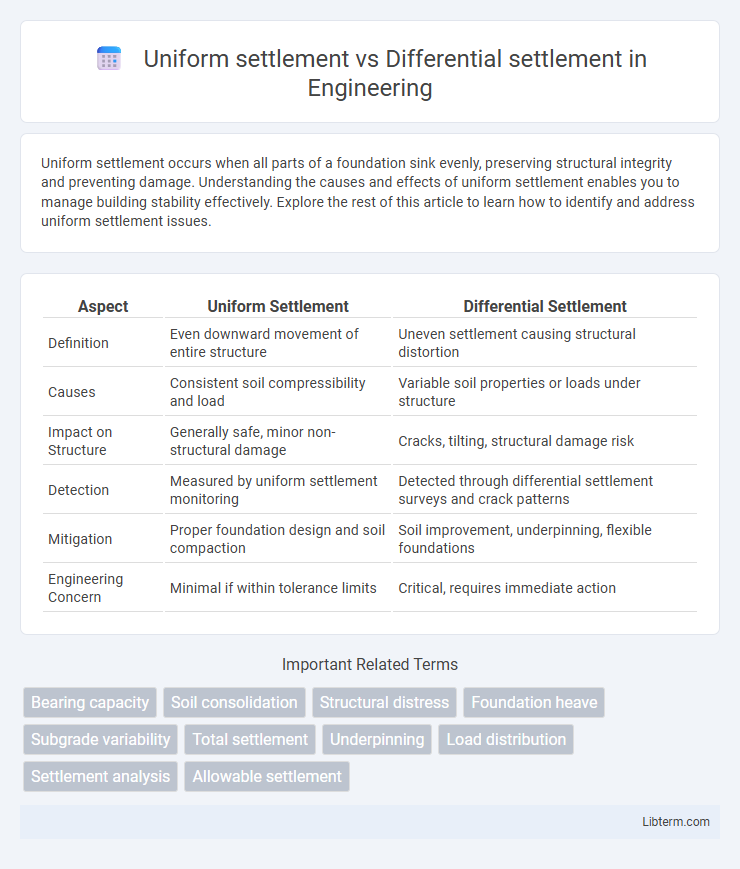Uniform settlement occurs when all parts of a foundation sink evenly, preserving structural integrity and preventing damage. Understanding the causes and effects of uniform settlement enables you to manage building stability effectively. Explore the rest of this article to learn how to identify and address uniform settlement issues.
Table of Comparison
| Aspect | Uniform Settlement | Differential Settlement |
|---|---|---|
| Definition | Even downward movement of entire structure | Uneven settlement causing structural distortion |
| Causes | Consistent soil compressibility and load | Variable soil properties or loads under structure |
| Impact on Structure | Generally safe, minor non-structural damage | Cracks, tilting, structural damage risk |
| Detection | Measured by uniform settlement monitoring | Detected through differential settlement surveys and crack patterns |
| Mitigation | Proper foundation design and soil compaction | Soil improvement, underpinning, flexible foundations |
| Engineering Concern | Minimal if within tolerance limits | Critical, requires immediate action |
Introduction to Settlement in Civil Engineering
Settlement in civil engineering refers to the downward movement of the ground caused by the weight of a structure. Uniform settlement occurs evenly across the foundation, ensuring structural integrity remains largely intact, while differential settlement happens when different parts of a foundation settle at varying rates, often leading to structural damage such as cracks. Understanding the distinction between uniform and differential settlement is crucial for designing foundations that maintain stability and safety over time.
Definition of Uniform Settlement
Uniform settlement occurs when an entire structure's foundation descends evenly and consistently, maintaining the building's structural integrity without causing distortions. Differential settlement refers to uneven sinking across different sections of a foundation, leading to potential structural damage such as cracks and misalignment. Understanding the distinction between uniform and differential settlement is crucial for designing foundations that minimize structural risks.
Definition of Differential Settlement
Differential settlement refers to the uneven sinking or settling of different parts of a structure's foundation due to variations in soil properties, load distribution, or moisture content. Unlike uniform settlement, where the entire structure settles evenly without causing significant structural damage, differential settlement leads to distortions, cracks, and potential structural failure. Engineers monitor differential settlement closely to design foundations that minimize structural risks and maintain long-term stability.
Causes of Uniform Settlement
Uniform settlement occurs when an entire structure sinks evenly due to consistent soil conditions and load distribution beneath the foundation. Causes of uniform settlement include soil consolidation under sustained load, uniform moisture content changes, and natural soil compression over time, typically in clay or silt layers. Proper geotechnical investigation and foundation design can mitigate risks associated with uniform settlement.
Causes of Differential Settlement
Differential settlement occurs when different parts of a structure settle at varying rates due to non-uniform soil conditions, varying load distributions, or changes in moisture content beneath the foundation. Causes include the presence of compressible layers such as clay or peat beneath one section, unevenly distributed structural loads, and varying soil compaction or consolidation rates. Unlike uniform settlement, which evenly affects a structure, differential settlement leads to structural distortions, cracks, and potential failure due to uneven foundation movement.
Effects of Uniform Settlement on Structures
Uniform settlement results in a consistent downward movement of a structure's entire foundation, minimizing internal stresses and reducing the likelihood of structural damage such as cracking or tilting. This type of settlement generally preserves the integrity of load-bearing walls and columns, maintaining overall stability and alignment. Uniform settlement is often more manageable in engineering design, allowing for adjustments without significant repair costs or safety concerns.
Effects of Differential Settlement on Structures
Differential settlement causes uneven displacement in a building's foundation, leading to structural distortions such as cracks in walls, misaligned doors and windows, and uneven floors. This type of settlement imposes additional stresses on the load-bearing elements, potentially resulting in structural instability or failure over time. Unlike uniform settlement, which typically produces minimal impact, differential settlement demands careful monitoring and remediation to ensure the integrity and safety of infrastructure.
Methods for Controlling Uniform and Differential Settlement
Methods for controlling uniform settlement include proper soil compaction, preloading, and using deep foundation systems such as piles or drilled shafts to distribute loads evenly. Differential settlement control focuses on mitigating uneven ground movement through soil improvement techniques like grouting, installing geosynthetics, or constructing rigid mats and rafts to enhance load distribution and stiffness. Advanced monitoring systems and site-specific geotechnical investigations are essential for designing effective settlement control strategies tailored to uniform or differential settlement risks.
Case Studies: Uniform vs Differential Settlement
Case studies of uniform versus differential settlement reveal distinct impacts on structural integrity, with uniform settlement causing overall sinking without significant damage, as seen in the Leaning Tower of Pisa's early years before soil correction. Differential settlement often results in uneven foundation movement, leading to cracks and structural distress exemplified by the damages to the Kansas City Hyatt Regency walkway collapse site due to soil variability. Detailed monitoring and soil analysis in these cases highlight the critical need for tailored foundation design to mitigate settlement risks and preserve building safety.
Conclusion and Best Practices
Uniform settlement occurs evenly across a foundation, minimizing structural stress, while differential settlement causes uneven sinking that can lead to cracks and instability. Best practices include thorough geotechnical investigations, proper foundation design tailored to soil conditions, and continuous monitoring during and after construction. Addressing potential settlement through soil improvement methods and flexible structural components enhances long-term building performance and safety.
Uniform settlement Infographic

 libterm.com
libterm.com